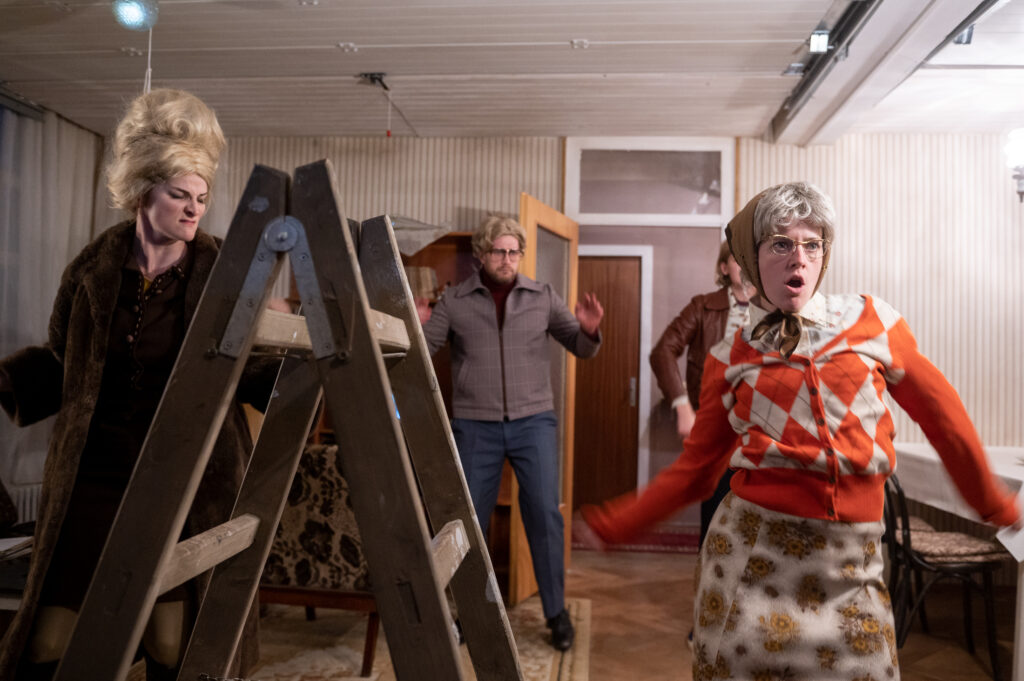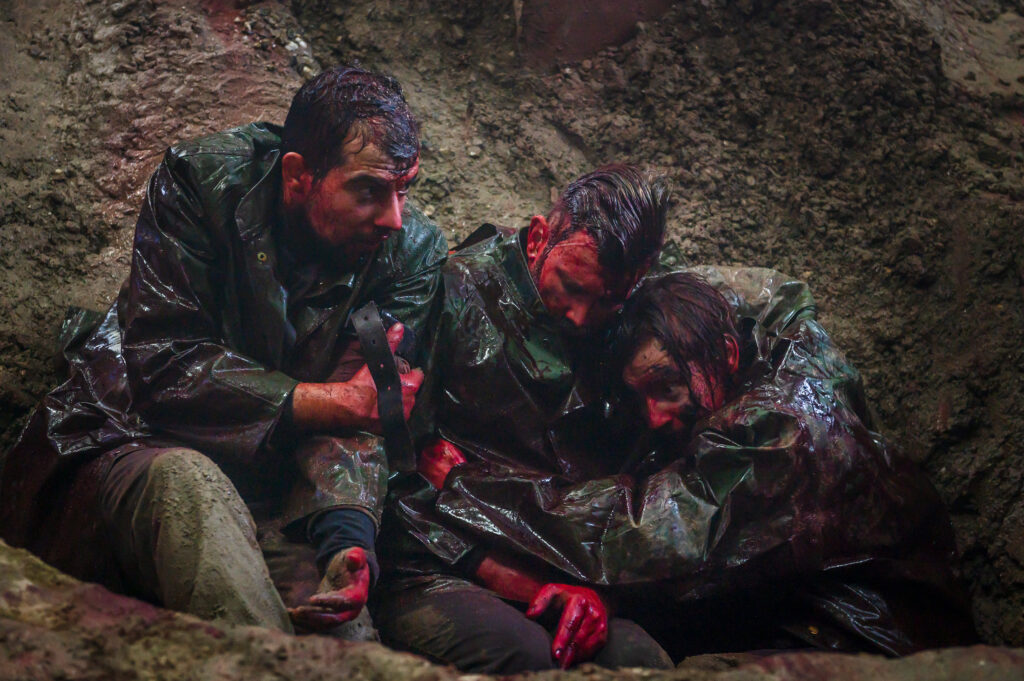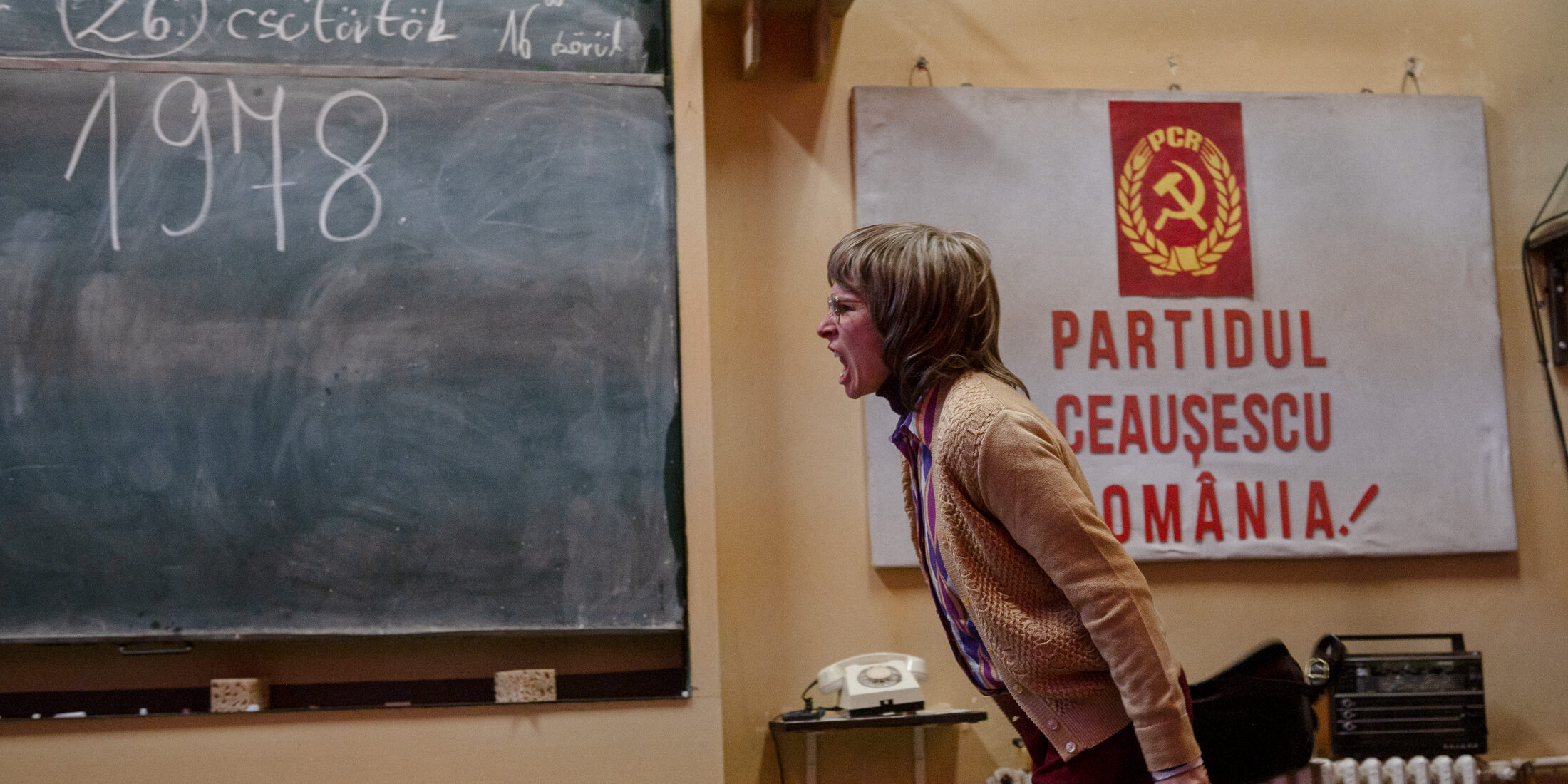“Csiky Gergely” Hungarian State Theatre, Timișoara, premiere 7th December 2023
This is the way to do theatre! I say this with conviction, even if during Tomi Janežič’s five-and-a-half-hour mega-project in Timisoara, especially towards the end, I felt several times that what I was seeing and feeling was unbearable and intolerable. (And that’s not even taking into account how the actors manage to endure it).
Yet it must be said that such a performance cannot be prepared anywhere, with anyone. To understand why here and why now, we need to talk about the location. Timișoara, a trilingual Romanian city of a quarter of a million inhabitants, is home to the Csiky Gergely Hungarian State Theatre, which recently celebrated its 70th anniversary and has consistently produced work at a high level, including work by theatremakers, such as Andrei Șerban, Bojan Jablanovec, Kokan Mladenović, Radu Afrim, Árpád Schilling, Silviu Purcărete or András Urbán: they have all worked here during Attila Balázs’ tenure as a general manager since 2007.
The region’s defining festival, the Timișoara Euroregional Theatre Festival (or TESZT), has attracted prestigious directors mainly from the south and east of Europe since its inception in 2008. TESZT has also become a testing ground: many of the directors of successful productions have been invited to produce their own shows at the Hungarian theatre of Timișoara. The institution is not just speaking to the city’s dwindling Hungarian-speaking population, but dares to think on a European scale.
The audience of TESZT has already seen work by Janežič, with The Seagull (2013), The Death of Ivan Ilyich (2015) and most recently no title yet (2022). Timișoara audiences are now familiar with Janežič’s theatrical language, or at least understand that if they buy tickets to his shows, they will not be seeing a light comedy. Nor are the actors in Timișoara jumping into the void without a safety net – they have prior knowledge.
For the creation of a show like this, outside a theatre building, under harsh conditions, and with the creative energy of many contributors, to be possible, it requires an exceptional constellation of stars.

1978 – “Csiky Gergely” Hungarian State Theatre
A bus takes us to the once glorious Faculty of Hydrotechnics at the Technical University of Timisoara, a good twenty minutes ride from the city centre. An abandoned building, which, from a historical perspective, is now filled with life for a few moments by the theatre people – we discover early on that the place will be also filled with death. Dull plaster, dirty walls, Toi-Toi toilets in the weedy garden. There is no heating in the building, so warm clothes are compulsory and hot tea is recommended – all factors that will excite rather than deter the professional theatre-goer. Leaving the cosy theatre space behind us becomes a journey through time without the creators having worked hard to do so: welcome to 1978, Romania. Or Hungary. Or anywhere in Eastern Europe.
The three long chapters of the performance take us to at least three worlds – in space and time. As the hours pass, we sink lower and lower, not only metaphorically. For the first part, we stagger up to the second floor of a staircase once trodden by crowds to confront the transformed reality of a university auditorium. In the second section, we are on the first floor, watching a witty and clever film insert in a tiny room, then to see the space transform completely with a brilliant scenic trick, and again, a different perspective on the lives of the people behind the walls. Finally, we get down to the ground floor, or even deeper: the intolerable proximity of the trenches of the First World Warprovokes a primary physical reaction – and not just from the audience.
Where we are is perhaps already outlined, when is a more complicated matter. The first part reminded me strongly of Alvis Hermanis’ iconic Long Life (and The Sound of Silence) and Radu Afrim’s Retro bird hits the block and falls on hot asphalt: the lives of neighbours and acquaintances, strangers and family members, brought together under functioning socialism by necessity rather than by choice, are brought to life in vivid images. Back to the time: a date, apparently set with engineering precision, is explored with exhaustive thoroughness, a long-ago Thursday, 26 January 1978, at around 4 pm.
If we were in Romania forty-five years ago, everyone would be chanting: it is Nicolae Ceaușescu’s 60th birthday. Even if we didn’t know from the creators, it would be clear that Janežič prepared the whirlwind text together with the actors. It sounds cliché, but it is true: it involves all the actors (and always and constantly Janežič himself), neck-deep, their body and soul, with a past that they have lived personally or heard about from their relatives. The spectator is confronted with the unintended side effects of this particular creative method: not every actor is capable of filling the magical space of the play, which is drawn according to a set of rules, with content, depth and meaning – and this does not depend on age or experience, but rather on the actor’s attitude.
The performance also talks about the fact that we cannot, because we do not have to step outside the history we have been given. The premise behind Janežič’s performance, the stakes of this monstrous theatrical experiment, are deadly serious: how is the past, the present, and, I fear, the consequent future reflected in a single moment in time? The temptation of the impossible in Tomi Janežič’s theatre is a fundamental gift: as with other directors working on a similar scale, the extreme demands on the actor’s and the spectator’s body, perception and thinking are paramount. Theatre becomes life and life becomes theatre, and the blurred line between the two is both exhilarating and unsettling.
So 26 January 1978, at 4 pm. The first hour and a half is a masterly case study of life, memory and history. But it’s all about trivialities, not even the atrocities of the dictator. That’s not true: the scars are there on the smiling faces. Somehow, just try to imagine that in the first half of the sentences of the impressionistic text, there is the TV series Roots, an exploded coffee pot, a school essay, a can of Coca-Cola, a Rolling Stones T-shirt, and in the second half of the sentences, police interrogation, beatings, escape attempts, smuggling. The two parts do not contradict, but complement each other: this is how we approach completeness.
The protagonist of this stream-of-consciousness, restless narrative is Zsolt. We hear the voice of the actor Zsolt Mátyás, but we do not see him, while he hears what the others or Janežič say to him, ask him. The magic lasts for a long time – and I am absolutely sure that the actor only appears in the last few minutes of the play, in order to close and conclude this extraordinary adventure with his physical presence. Sadly, this is not what happens, and annoyingly, I am wrong: at the beginning of the wounding third act, Zsolt Mátyás enters personally a mini-universe drifting towards open-circuit apocalypse. And suddenly, the weight that had been perfectly present until then through the actor’s voice alone, disappears into nothingness.
The first part, despite the flashes of what are in fact constant horrors, is more of a bland nostalgia: to fully understand the schizophrenic two-facedness of the authoritarian regime, one must have lived in Central Eastern Europe in the seventies and eighties. The second part delves deeper into the sometimes life-giving, sometimes suffocating roots of Zsolt and his family, mixing the times we have already been informed about. Franz Joseph and the World War I, preceded by the deaths of Queen Sissi and Crown Prince Rudolf, become prominent in the story. Everything is still, while everything is in motion: borders and countries disappear into nothingness, while hundreds of thousands of people shivering in the trenches, tremble in the blockhouses, make plans to escape from here and there – yes, the timelines and locations slide together, forming an inextricable whole.

1978 – “Csiky Gergely” Hungarian State Theatre
If I believed in the necessity of naming those responsible, I could say that in the third part the creators let go of my hand, but it is more correct to say that I let go of theirs – either way, I am in the dark about what I have seen. We are in the spacious ground-floor hall of the dilapidated building: a fire burning on a stove along one wall, water drips from the ceiling in front of me, then pours onto used theatre curtains, huge earthworks in front of us, a (dangerously deep) pit next to it. Tomi Janežič’s physical presence in the previous stations was reassuring, confirming many things; here, for me at least, it is intrusive: he fogs the bodies shivering from the cold with a hand-held smoke machine, sprinkling them with fake blood. Everything that had hitherto, despite all its conscious dispersal, pointed firmly in one direction, or at least to one point, seems here to break into a thousand disparate pieces. And we are sitting at the bottom of a wet, muddy, bloody heap of earth, trying to fit the pieces together, trembling from the theatrically produced noises…
Is it appropriate for a critic to be biased and/or forgiving? I don’t know, probably not, but I’m going to generously overlook the prolonged finale that pushed me quite far away from the whole project. The 1978 is a significant, serious, man-testing, God-tempting undertaking, to which, if we submit ourselves, we can learn and understand all sorts of things about ourselves, our parents, our grandparents, that we have forgotten, or at least that someone really wants us to forget.
In 2025, Nova Goriza will be the European Capital of Culture, where 1978 will be presented as part of a series of twelve performances.
Credits:
Set design: Branko Hojnik//Costume: Marina Sremac//Choreography: Döbrei Dénes//Music and sound design: Samo Kutin, Eduardo Raon
Cast: Balázs Attila, Borbély B. Emília, Császár Mónika, Czüvek Loránd, Jancsó Előd, Kiss Attila, Lajter Márkó Ernesztó, Mátyás Zsolt Imre, Simó Emese, Szőllősi Eszter, Vajda Boróka
Jászay Tamas is a theatre critic, editor, university lecturer, and curator. Since 2003 he's been working as a freelance theatre critic: in the last 20 years he published more than 1200 articles (mostly reviews) in more than 20 magazines all around the world. Since 2008 he is co-editor, since 2021 editor-in-chief of the critical portal, Revizor (www.revizoronline.com). Between 2009 and 2016 he was working as the co-president of the Hungarian Theatre Critics' Association. In 2013 he defended his PhD thesis on the history of Krétakör Theatre (Chalk Circle Theatre). He regularly works as a curator too: Hungarian Showcase (Budapest, 2013), Szene Ungarn (Vienna, 2013), THEALTER Festival (Szeged, since 2014), dunaPart (Budapest, 2015, 2017, 2019, 2023). Since 2015 he's been teaching at Szeged University, since 2019 as an assistant professor.








